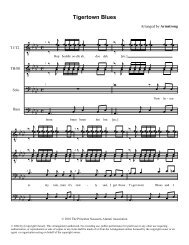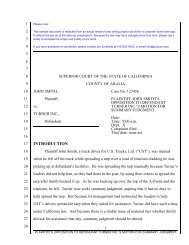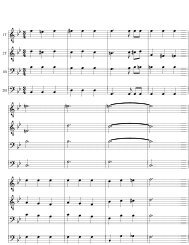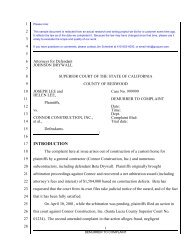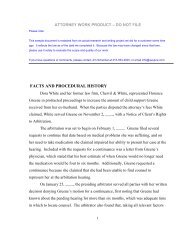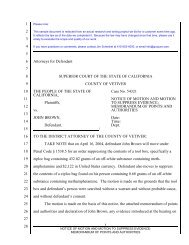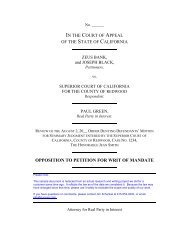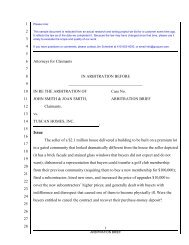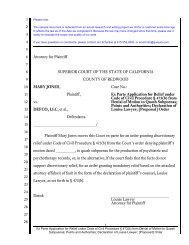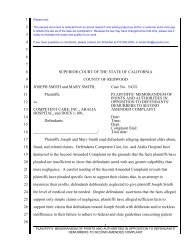Motion for Summary Judgment and/or Summary Adjudication
Motion for Summary Judgment and/or Summary Adjudication
Motion for Summary Judgment and/or Summary Adjudication
You also want an ePaper? Increase the reach of your titles
YUMPU automatically turns print PDFs into web optimized ePapers that Google loves.
1<br />
2<br />
3<br />
4<br />
5<br />
6<br />
7<br />
8<br />
9<br />
10<br />
11<br />
12<br />
13<br />
14<br />
15<br />
16<br />
17<br />
18<br />
19<br />
20<br />
21<br />
22<br />
23<br />
24<br />
25<br />
26<br />
27<br />
28<br />
3. As owner of a dominant tenement, plaintiff is entitled to en<strong>f<strong>or</strong></strong>ce the<br />
easement, <strong>and</strong> may obtain both damages <strong>and</strong> injunctive relief.<br />
The servient owner may not use his <strong>or</strong> her l<strong>and</strong> in a way that unreasonably<br />
interferes with the dominant owner’s easement rights. Blackm<strong>or</strong>e v. Powell (2007) 150<br />
Cal.App.4th 1593, 1599. The owner of any estate in the dominant tenement may<br />
maintain an action <strong>f<strong>or</strong></strong> the en<strong>f<strong>or</strong></strong>cement of an easement attached thereto. Civ. Code § 809;<br />
Jones v. Young (1957) 147 Cal.App.2d 496, 500.<br />
In Herzog v. Gross (1953) 41 Cal.2d 219, an action to quiet title to an easement <strong>f<strong>or</strong></strong><br />
road purposes over the defendant’s l<strong>and</strong>, the court upheld a judgment <strong>f<strong>or</strong></strong> damages <strong>and</strong><br />
injunctive relief against the defendants who unreasonably interfered with the adjoining<br />
property owners’ use <strong>and</strong> enjoyment of their easement <strong>f<strong>or</strong></strong> use of a private road to access<br />
their property. The defendants had erected a fence <strong>and</strong> gates <strong>and</strong> dumped quantities of<br />
dirt that blocked the passage of adjoining property owners over the private road. While<br />
noting that the defendants had the right to erect a guardrail of the type usually used on<br />
public highways, the court rejected the defendants’ contention that the fence <strong>and</strong> gates<br />
were needed to prevent mot<strong>or</strong>ists from mistaking the private road <strong>f<strong>or</strong></strong> a public road <strong>and</strong><br />
entering the defendants’ property; their property could be adequately protected by a sign<br />
that would not unreasonably interfere with the plaintiff’s use of the easement. Id. at 225.<br />
The appellate court upheld an award of damages <strong>f<strong>or</strong></strong> property damages, depreciation in<br />
value, <strong>and</strong> the cost of removing the 700 cubic yards of dirt the defendants dumped on the<br />
plaintiff’s property. It also <strong>or</strong>dered the defendants to alter the road so that it would<br />
con<strong>f<strong>or</strong></strong>m to the map showing the properties’ <strong>or</strong>iginal configuration. (But the trial court<br />
could not <strong>or</strong>der the defendants to pave the road, which was <strong>or</strong>iginally a dirt road on the<br />
easement.) Id. at 227-228.<br />
In Van Klompenburg v. Berghold (2005) 126 Cal.App.4th 345, the trial court<br />
entered judgment enjoining the owners of a servient tenement from maintaining gates<br />
across a private roadway, the only permanent means of accessing the plaintiff’s property.<br />
8<br />
NOTICE OF MOTION AND MOTION FOR SUMMARY JUDGMENT OR SUMMARY ADJUDICATION;<br />
PLAINTIFF’S MEMORANDUM OF POINTS AND AUTHORITIES



